On the trash-lined streets of downtown Manhattan, it’s terrier versus rat, to the death. Inside the worlds of R.A.T.S.
Tonight is trash night in Lower Manhattan, and where there is trash, there are rats. New York City has a lot of both. The city’s residents and businesses produce about 50,000 tons of residential and commercial waste each day, much of it food waste—uneaten bagels and unwanted pizza crusts, fish bones and meat scraps, coffee grounds and vegetable peels. In every neighborhood and borough, trash is collected in plastic bags and stored in apartment building courtyards and alleyway bins. On pickup days, which vary depending on neighborhood, bags are stacked high on sidewalks and left to sit, sometimes for hours, sometimes overnight—rotting and reeking—until a garbage truck comes to haul them away. For a rat, the time in between is the Golden Hour: the time to feed.
In City Hall Park, at 9:30 p.m., a small posse of dog enthusiasts has gathered under dim park lamps. They are members of a group who go by the noms de guerre R.A.T.S., an acronym for Ryders Alley Trencher-fed Society. Ryders Alley is a famously rat-infested alleyway in Lower Manhattan; “trencher-fed” is a 19th century term literally referring to a type of wooden bowl that was used to feed hunting hounds, but over time came to describe the hounds that lived together with their owners for use in group hunts. R.A.T.S. meets when its members can, sometimes as often as once a week. When they meet, they hunt, stalking New York’s rat-infested alleyways and housing projects to chase down the city’s pestilent whiskered menace.
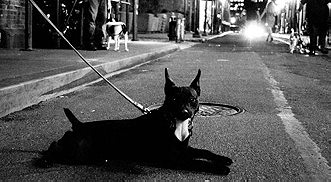
Tonight’s hunting ground is Theatre Alley, between Beekman and Ann Streets, a short walk from the park. The alley was once at the epicenter of the Broadway of its day. As far back as the 18th century, it served as a service lane for carriages bringing theatergoers to Park Theatre, John Street Theatre, Chatham Garden Theatre, and the Nassau Street Theatre. Works by Shakespeare were often performed—Hamlet had its American premier here in 1761—and George Washington was known to walk the cobblestone alleyway on his way to catch a show. The theaters are long gone; today, the alley lines commercial real estate.
R.A.T.S. often comes to hunt at Theatre Alley, where pedestrians are few and garbage is left to sit undisturbed for hours at a time—in other words, a place where rats are plentiful. It’s an eclectic group of dog lovers: men and women, young and old, from New Jersey, Manhattan, Brooklyn, and Queens, wearing cargo pants and fanny packs. Their dogs are primarily breeds of terriers, dogs that were for centuries bred to hunt vermin on farmers’ fields. Tonight, the dogs yap and sniff and scuffle as the group waits for a few late arrivals.
New York City is in many ways a rat paradise.
Judy Todd, from Tom’s River, New Jersey, with eyeglasses and short gray hair under a hat, sits on a bench wearing a black shirt with white lettering that reads “Rat Patrol.” Her dog, a 7-year-old border terrier named Merlin, is calmly perched beside her wearing a yellow vest, panting.
Richard Reynolds, R.A.T.S. lead evangelizer, taps me on the shoulder. “You’ll want to watch that one,” he says, nodding toward Merlin. “He’s a hunter.” Reynolds is wearing a baseball cap and a loose-fitting shirt with baggy pockets. He’s holding a leash attached to his dog Catcher, a six-month-old Bedlington terrier, who has so far only been a bystander on these hunts. Up till now he’s been too young and under-trained, but tonight, Reynolds hopes to allow him in on the action.
A few more participants arrive with their dogs; passersby look on curiously as they wander past. When everyone is ready, we make the short walk to Theatre Alley, where the warm, humid air is filled with a sickly-sweet odor—something like spilled soda, or aged cheese, or urine. The alley is perfect for rat hunting: garbage bags are piled at the mid-point, and the alley’s entrances are far enough away that the dogs aren’t at risk of jetting out into traffic and getting struck by a car, which is one of the dangers of hunting in Manhattan.
Reynolds divides the group into two teams; one enters from the north side, the other from the south, slowly approaching the trash pile from two flanks. Once both teams near the alley’s midway point, Reynolds yells for everybody to stop. Dogs bark and strain at their leashes. Tails wag like mad. It’s 9:55 p.m.
“Okay,” he shouts, “let ‘em go!”
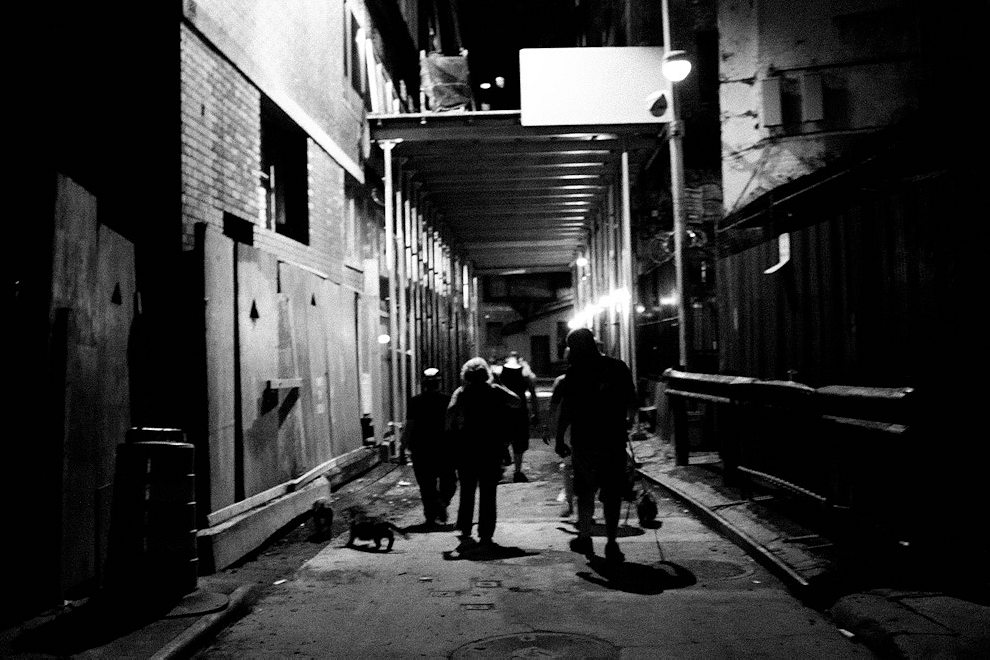

1. Ancient Foes
Terriers and rats are historic enemies. Different types of terriers were bred to hunt different vermin—border terriers, Jack Russells, and fox terriers to flush out foxes from their dens; Bedlington terriers by poachers to hunt rabbits; Kerin and Manchester terriers for rats—and have been doing it for centuries in the United Kingdom and the United States. Rat terriers are a fairly modern breed, a descendent of the feist, a small hunting dog. (Reynolds says it is tough to define what a rat terrier is, exactly, and he is skeptical they are especially good at hunting rats: “Just because a dog has a name, doesn’t mean the name is significant.”) Rat terriers were introduced to the U.S. in the 1890s and stalked American farms for decades before poison and pesticides rendered them obsolete. President Theodore Roosevelt supposedly kept rat terriers as house pets, sometimes taking them on hunts.
At one point London was home to some 70 rat pits
Terriers were used to rid streets of rats in some cities: an 1851 examination of working class life in London referred to rat catchers working the streets with ferrets and terriers. Beginning in the early 1800s, terriers were used in a blood sport called “rat-baiting,” or “ratting,” which involved filling a pit with rats and taking bets on how long it would take the dog to kill them, or on how many the dog could kill within a given time frame. Rat-baiting was popular in the United Kingdom for the better part of a century, until the last public competition in 1912. At one point London was home to some 70 rat pits.
New Yorkers, too, were fond of ratting, and an evening at the rat pit was once a popular activity for gambling aficionados. Perhaps the city’s most infamous ratter was Christopher Keyburn, better known as Kit Burns, the red-bearded proprietor of Sportsman’s Hall at 273 Water Street. (The building, the third oldest in the city, still stands; it has been turned into luxury apartments.) Burns was a prominent member of the Dead Rabbits gang, made famous in Martin Scorsese’s Gangs of New York, and Sportsman’s Hall was ostensibly a tavern, but it made a large portion of its revenue from bare-knuckle boxing matches, dog fights, and rat killing extravaganzas. As James Dabney McCabe writes in the 1868 book Secrets of the Great City, “Rats are plentiful along the East River, and Burns has no difficulty in procuring as many as he desires… A number of rats are turned into this pit, and a dog of the best feral stock is thrown in amongst them. The creature at once falls to work to kill the rats, bets being made that she will destroy so many rats in a given time.”
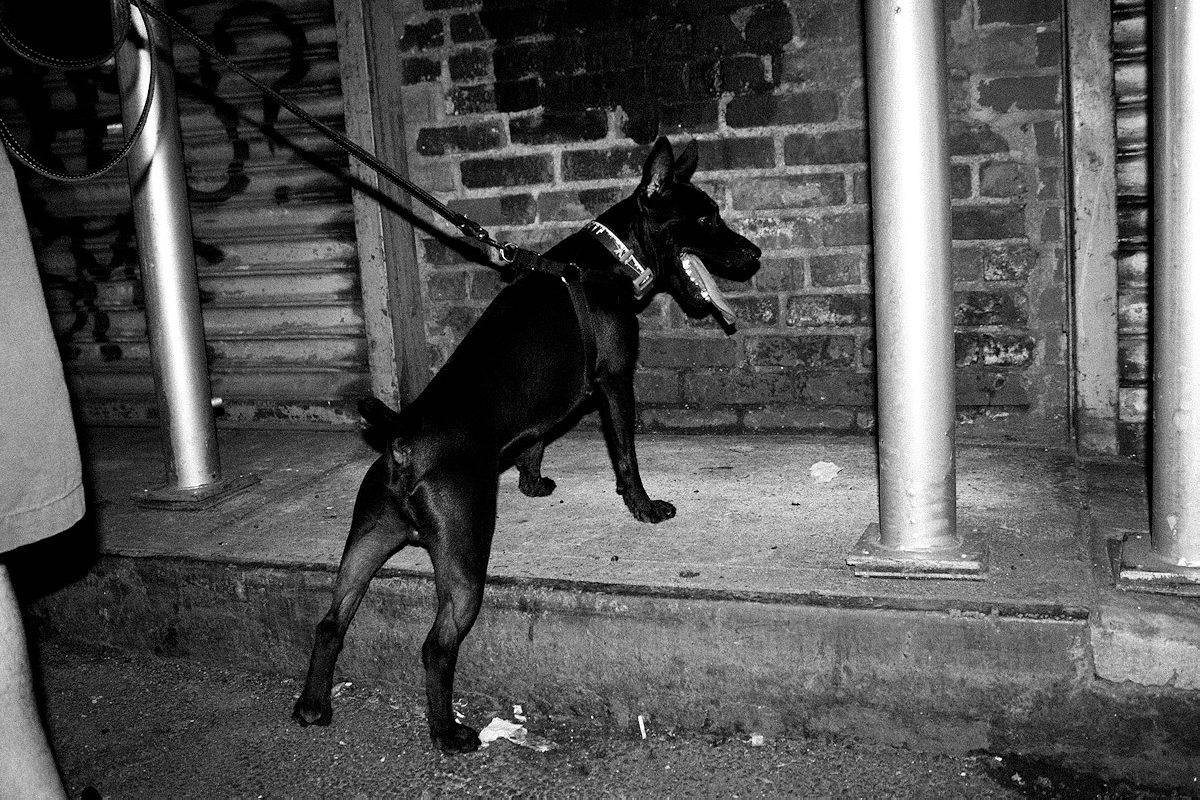
Hard times eventually fell upon Burns, who leased Sportsman’s Hall to a missionary and opened a smaller saloon on Water Street called the Bandbox, where he continued to hold ratting events. It was an advertisement for an event at the Bandbox on the evening of November 21, 1870, with Burns promising “a good night’s sport and no humbug” and offering 300 rats to be “given away, free of charge, for gentlemen to try their dogs with,” that caught the eye of Henry Bergh, founder of the American Society for the Prevention of Cruelty of Animals (ASPCA). Four years earlier Bergh had successfully lobbied for an anti-animal cruelty law to be passed by the New York state legislature. Bergh personally led the raid and Burns was arrested. Burns died before facing trial, at age 39, of what was likely pneumonia or diphtheria developed from a cold he caught in his holding cell. His saloon was shuttered. Bergh would later boast of Burns, “I drove him out of New York and into his grave.”
Today, the brutal scale is gone, but the tradition of hunting rats with terriers lives on, and not just with R.A.T.S. Rat-tracking recently became an official canine sport in the United States, called “barn hunt.” Dogs are allowed two minutes to sniff around a hay-bale maze and indicate where they smell a rat in a tube. The first trials were conducted in April in Columbia, Missouri, where dozens of dogs competed. No rats are killed in the sport.
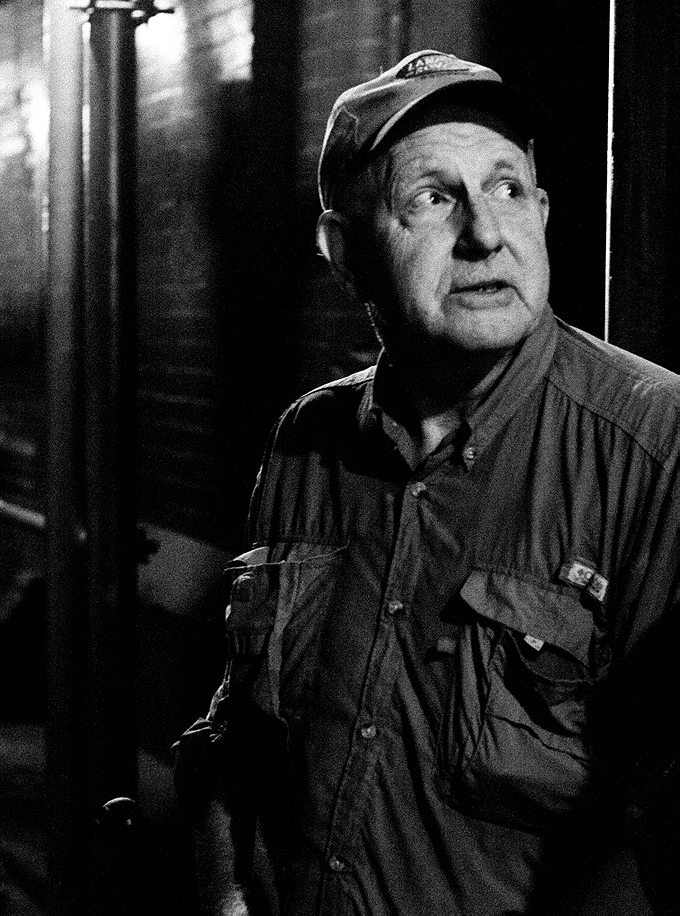
Richard Reynolds, R.A.T.S.’s genial point man, is tall and lumbering, with cropped white hair and a pleasant upstate New York drawl. He’s been fascinated with dogs (which he pronounces dw’ogs) his entire life. He is an American Kennel Club certified dog breeder and dog show judge.
I meet Reynolds one afternoon a few weeks before the Theatre Alley hunt at the ferry terminal in Edgewater, New Jersey, where he picks me up in his Land Rover. He’s happy to get exposure for his group, but a bit wary of the media’s natural fixation on the blood in the sport. “Everybody’s focused on killing rats, but that’s really not what we’re about. We do, but that’s not the whole thing,” he says.
The whole thing, he says, is about the dogs. Reynolds loves dogs. He owns eight of them, six of which he keeps at home, and they bark at us through a fence in the backyard as we enter his house. Reynolds makes us coffee and I sit in his study, surrounded by dog paraphernalia. There are photos of Reynolds and his dogs and a fox head mounted on the wall. (“That particular one? I cheated. I bought it.”) On his coffee table is a chess set with the participants of a British foxhunt for pieces.
Reynolds, a business consultant by day, has been fascinated with dogs since he was a boy growing up in Syracuse, N.Y. “All the other guys were keeping Playboys under their beds and I was keeping National Geographic magazines with articles about dog shows,” he jokes. Once, when he was working at veterinary hospital as a teenager, he took pity on a beagle being kept for use as a blood donor, and decided to steal it. He eventually returned the dog and was promptly fired, “but that sort of started it,” he says. Reynolds has bred terriers for hunting, judged shows and performance tests, and participated in foxhunts as far away as England. “The majority of us who do this are dogs nuts and we’ve been doing this for the better part of our lives,” he says.
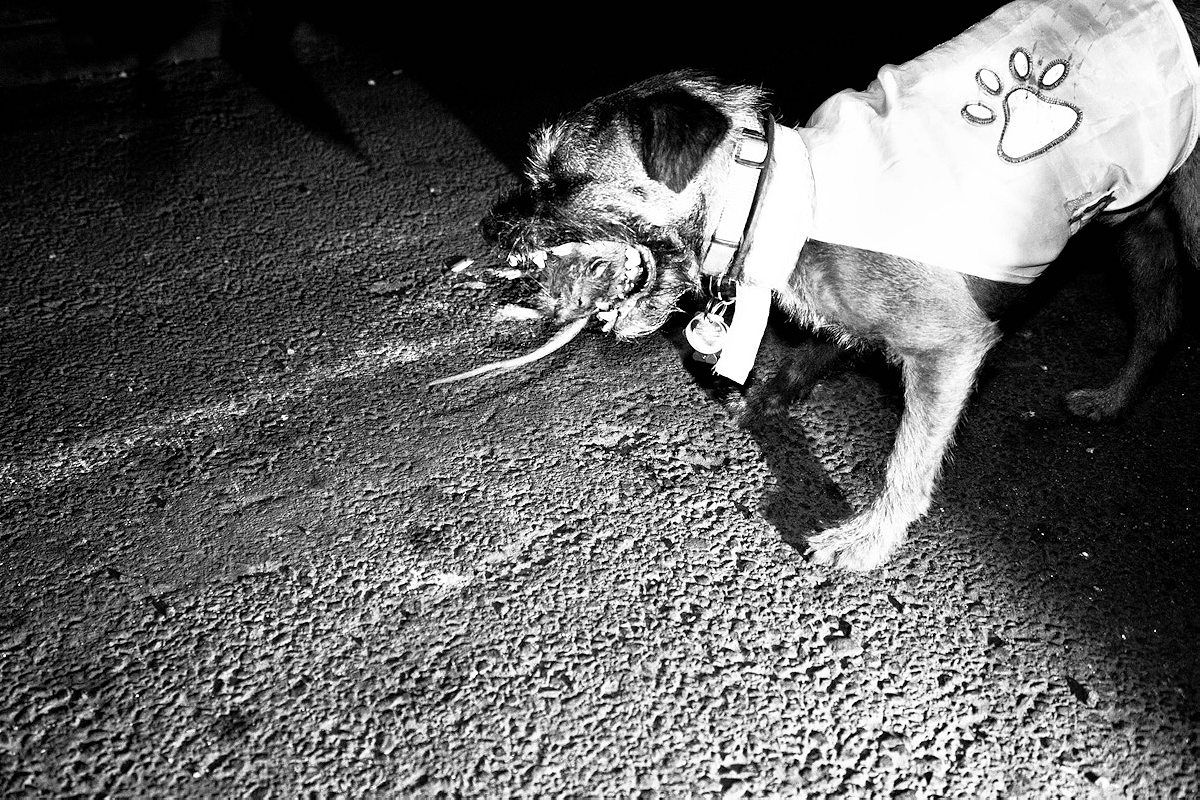
R.A.T.S. hunts in teams of up to eight dogs. They’ll turn away dogs if the group gets too big. The smaller dogs, such as Dachshunds, Jack Russells, and Scotties, go in first, burrowing into to the stacks of trash to scare out the rats. The long-legged breeds (those with “all balls, no brains,” as Reynolds says, such as Irish terriers and border terriers) then chase the rats down. The dogs’ jaws are strong, and once grasped the rats stand little chance. A quick bite or a furious shake and the rat is dead. The dog will trot its kill to its owner, who will pry it out of the mouth and deposit it into a bag.
You figure out the rats’ escape routes and you put your biggest set of jaws there
“Rats move in pre-determined pathways,” he explains. “They know where they’re going to run. In an alley, you figure out their escape routes and you put your biggest set of jaws there. You catch more rats that way.”
The point of the rat hunts, he says, is to allow the dogs do what they naturally do: hunt and kill vermin. The dogs are not rewarded with treats while hunting—“the privilege of hunting quarry is the reward in and of itself,” Reynolds says. To correct a dog’s behavior, it will be given a time out from hunting. In the summer, R.A.T.S. hunts woodchucks. They also breed hybrid lab and wild rats with which to train the dogs. They had previously tried with lab rats alone, an experiment that failed. “With lab rats,” says Reynolds, “there’s a genetic disposition to roll over and say ‘kill me.’”
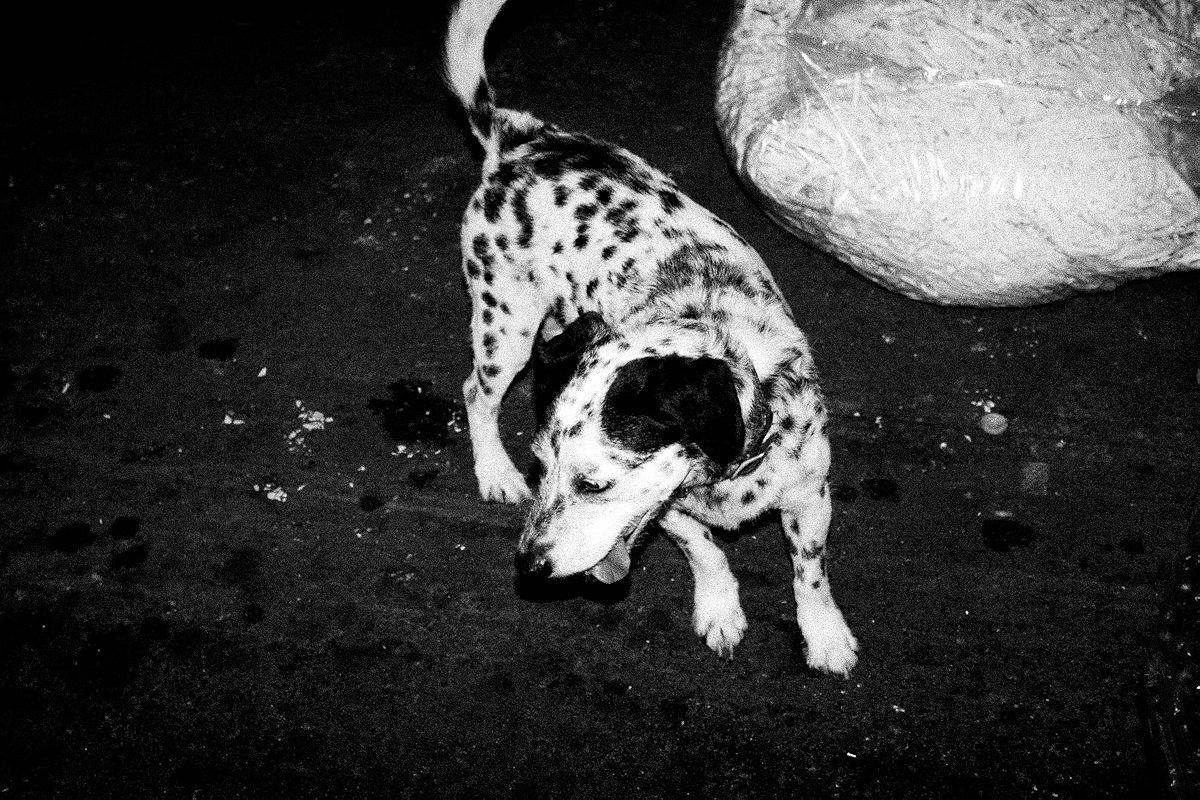
To breed the hybrids, a male wild rat is placed in a 55-gallon plastic drum with the top cut off at a point high enough that the rat, which can jump about 2.5 feet, can’t escape. After a few days, a female lab rat is introduced and, rats being rats, she’s soon pregnant. She’s then removed from the drum to give birth. (It’s always a wild male and domesticated female, because lab rats can be handled, while wild rats cannot.)
The rats are bred on private farms and the offspring sell for about $25 each. They’re used in American Kennel Society “earth dog tests”—standardized tests used to prove terriers’ gameness. The rats are kept in cages and the dogs aren’t allowed to come in contact with them. “The dogs bark, the rats hiss,” Reynolds says. “It’s a non-threatening way to start the dogs working… For a dog to be good at this it takes about a year of on-the-job training. A dog knows how to hunt at some point. Usually between one and four years, when the switch goes on and it says, ‘Okay, I’m tough.’ But they have to have the genetic disposition, and secondly the training.”
Reynolds is careful to point out that the hunts are not an effective means of rat control
Once a dog passes the Kennel Society tests, it can hunt. On hunts in the city, the dogs sometimes catch dozens of rats, but more often the body count is much lower. No matter how good the dogs are at hunting, rats are also good at escaping, and Reynolds is careful to point out that the hunts are not an effective means of rat control. “Totally, completely, absolutely a waste of time,” he says.
The dogs’ safety is paramount. R.A.T.S. will only hunt in places with little traffic and where they can easily contain the dogs. Alleys are best. Dogs sometimes get stuck in trashcans or stumble into holes, and they get the odd bloody snout from a rat claw, but none has been seriously harmed or gotten sick. The group tries not to go out in the rain—the theory being that rats don’t go out to feed when barometric pressure drops.
The city turns a blind eye to the rat hunts because they at least give the impression that something is being done to battle the rat problem
R.A.T.S. is always looking for good places to hunt in the city. The group used to hunt near the World Trade Center, and was out hunting the night before September 11, 2001. After 9/11, the group migrated to places like Ellis Island (where a group member’s political connection allowed them to hunt, Reynolds says), the Fulton Fish Market, and Ryders Alley.
They have a few go-to spots—Theatre Alley and other alleyways in Lower Manhattan—but they also make an effort to respond to every citizen who contacts them with reports of rat infestations, even if it’s unlikely they will be able to use the location for a hunt. Ever since the group was featured in some television segments, those inquiries have grown more frequent. He says the city turns a blind eye to the rat hunts because, in his opinion, R.A.T.S.’ presence in the city gives the impression that something is being done to battle the rat problem. “We pretend we don’t talk to the city, and the city pretends it doesn’t talk to us.” Reynolds says there is no specific law that forbids rat hunting in the city. “We enjoy a very cordial non-relationship with the city. They’re always 150% happy to help, and 150% co-operative. [But] for a variety of reasons they don’t recognize our existence and we try not to give them a bad name.”
The joy of hunting, he says, is watching the dogs do what they do best. “Every dog should be able to do what it was originally bred to do,” he says. “There is nothing, absolutely nothing, that these dogs enjoy more in their lives than hunting rats. It’s twenty minutes of mayhem.”
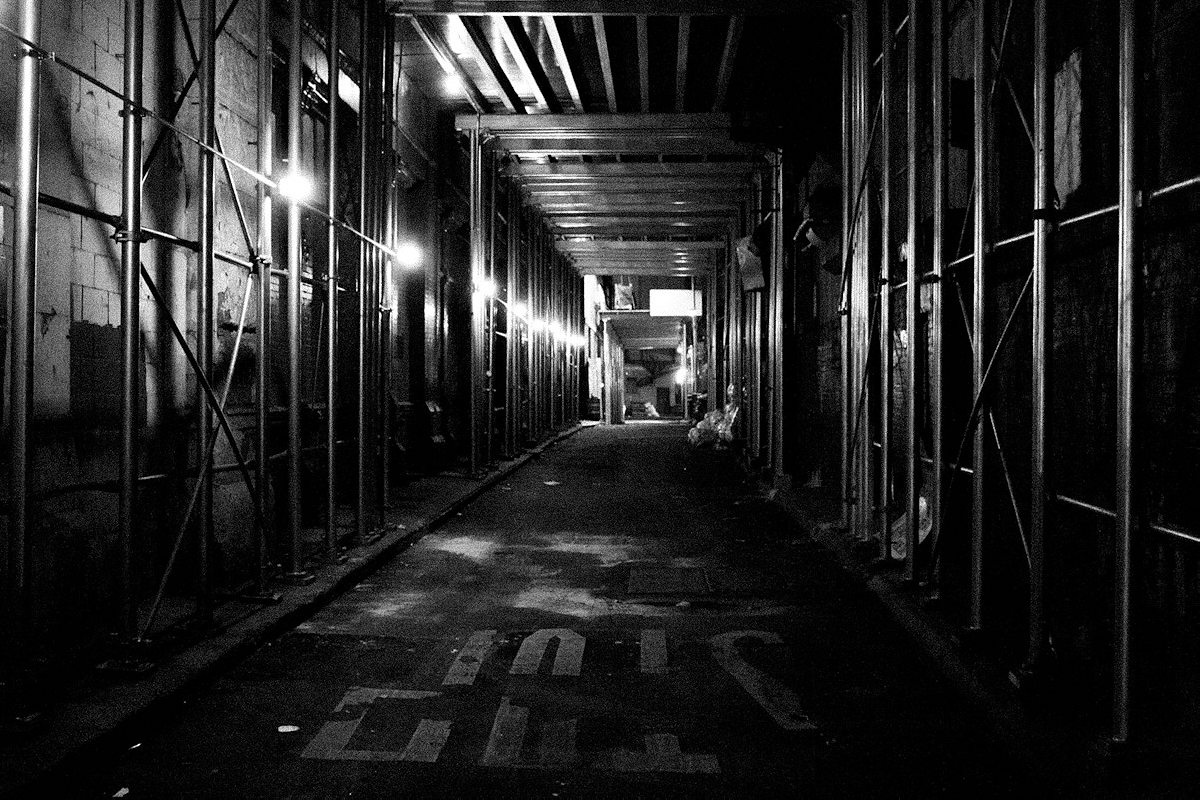
Nobody knows how many rats exist in New York City, beyond the bromide that there is a rat for every person. In his 2004 book Rats, writer Robert Sullivan argues that claim is a myth: there are actually far fewer rats than people in New York. But estimates vary wildly, from as low as 250,000 to more than twenty million.
The most common type of rat in New York City is the Norway rat—rattus norvegicus. Also called the brown rat, rattus norvegicus grows to approximately sixteen inches from nose to tip of the tail and weighs roughly a pound. They are brown or grey with a light grey or yellow belly. They live between about five and 12 months, and a female rat, which reaches sexual maturely in eight to twelve weeks, can have as many as seven litters a year with up to 12 pups per litter.
Many of the 50,000 victims of rat bites in the U.S. each year are children, because rats can smell the food residue on their faces
Norway rats have poor eyesight but a remarkable sense of smell. Sullivan writes that many of the 50,000 victims of rat bites in the U.S. each year are children, because rats can smell the food residue on their faces. Rats can smell poison down to one part per million, which is why rat poison is not an especially effective means of population control. Norway rats’ two front incisors are hard as steel and grow at a rate of five inches per year. Their bite exerts pressure of up to seven thousand pounds per square inch—two to three times that of an alligator, depending on the estimate.
But for all their strengths, rats only survive and thrive because we do. “I think of rats as our mirror species, reversed but the same, thriving or suffering in the very cities where we do the same,” Sullivan writes in Rats. Humans are a prolific producer of food waste, and rats feed on our leftovers. They live close by reliable food sources—often near restaurants and other places where garbage collects. They make their homes in alleys, under sidewalks, in apartment walls and floorboards, sewers, and subway tunnels. New York has all of these in ample supply; small wonder that commuters stand a one in ten chance, according to one study, of spotting a rat anytime they wait for the subway.
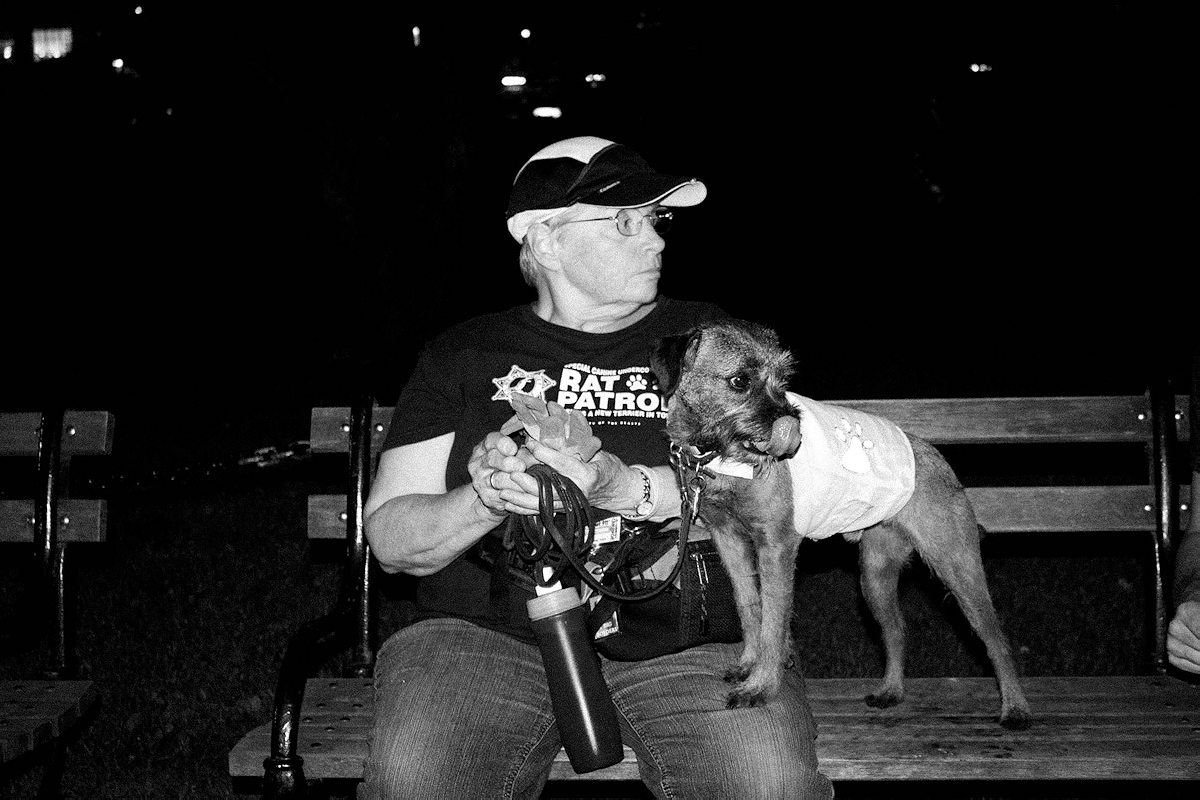
The real problem in New York, however, is the way the city handles its trash. Because New York’s trash collection system requires that trash-filled bags be left piled on sidewalks and elsewhere, often for many hours at a time, the city is in many ways a rat paradise. (I spent six years living in Beijing, a city of some 20 million people with no shortage of waste, but where garbage is collected continuously throughout the day, and never once saw a rat.) Rats develop an internal mapping of their surroundings and follow the same route day after day—it is said that if you removed the walls, holes, and pavement that make up a rat’s surroundings, it would continue to run the same route, so ingrained are its surroundings in its muscle memory. They can be found everywhere in New York City, but an individual rat will not travel far within their own limits.
People despise rats for many reasons—as carriers of disease, they are thought to be responsible for the deaths of more than ten million people—but none can doubt that they are incredibly resourceful animals. They live in nests that are entered by a corridor that can be as narrow as ¾ of an inch. The nests have an escape tunnel, called a bolt hole, which leads to a separate exit that is sometimes covered in debris to disguise its existence.
A rat would need to consume roughly 10% of its body weight in the MTA’s birth-control-poison for 5-10 days before it becomes sterile.
The city has tried a number of ways to control the rat population, above all with poison. The poison is put in small boxes called bait stations, a method that is so useless, Reynolds says, that rats often use the bait station as hiding places. The most common poison is anticoagulants, a blood thinner that causes the rat to bleed to death internally. Recently, the Metropolitan Transportation Authority (MTA) agreed to allow testing of a form of rat birth control in certain New York City subway stations. The product, called ContraPest, developed by an Arizona-based company that has conducted research in agricultural communities with rat problems, particularly on rice farms in Laos, India, and the Philippines, sterilizes female rats. The method has its own challenges, however: according to an MTA factsheet, a rat would need to consume roughly ten percent of its body weight in ContraPest for five to ten days before it becomes sterile.
Although the city has not commented on R.A.T.S., rat hunting is not without controversy. People for the Ethical Treatment of Animals (PETA) condemned the terrier rat hunts when a video of a dog snatching rats in a New York park appeared online in 2011. In an interview with the Associated Press in April, PETA Spokesman Martin Mersereau called rat hunting in New York “a twisted blood sport masquerading as rodent control.”
It is illegal in New York State to injure, maim, mutilate, or kill any animal, but whether that includes rats, which the city itself tries to kill (and in fact encourages its citizens to do the same—step five of the city’s rat control guide is titled “Wipe Them Out”), is uncertain. Reynolds says rat hunting with dogs is no more brutal than the other types of rat control. Rats caught in traps, especially those that use glue, can take days to die, and anticoagulants can also result in a long, arduous death, he says. “It’s barbaric, cruel, and ineffective.”
And here’s the irony about the leader of the rat-killing terriers: he’s actually a big fan of rats. “When you hunt something you have to like it and respect it,” he says. “I cheer for the rats.”

2. Reconnaissance
In Washington Heights later that night, a woman standing on a stoop near a reported rat infestation is trying to point us in the right direction. Go to 159th Street between Amsterdam and Broadway, she says. You’ll find rats. Too many to count. Rats with no fear. Rats that run across your feet as you walk. “Those rats up there have no respect,” the woman says, growing increasingly animated. “Daytime, nighttime. They don’t respect. You all need to bring your dogs.”
Reynolds and Jeff Formosa, an amateur videographer whose wife belongs to the same kennel club as Reynolds, have been sleuthing around this corner of Manhattan for the last twenty minutes, looking for signs of rats. Reynolds received an email from a man in the neighborhood regarding an infestation a few weeks earlier, and we’ve come to investigate. We poke around a row of trashcans, where a mounted sign reads, “PLEASE keep lids closed to prevent RATS,” and we peak into a small, triangular park across the street. Formosa records the search with his camera, gathering footage he hopes to use as B-roll for a reality show that so far has yet to materialize.
Because the park is fenced off, it would be ideal for hunting with the dogs. But hunting in parks is tricky. It requires a tool called smokers, which are currently only available in the U.K. (Reynolds is currently working on his own version—essentially a converted mosquito smoker—but it’s not game-ready yet.) In England, hunters also use converted chainsaws to scare the rats out of their holes, but that’s too noisy for late-night Manhattan, especially for an unauthorized brigade of rat hunters. R.A.T.S. has tried hunting in parks before without smokers, but with little success; the rats feed too close to their burrows for the dogs to be effective.
Regardless, there don’t seem to be any rats here. “It’s too early,” Reynolds says. Rats come out to feed when humans have gone to bed, and on this warm night, around 10 p.m., there are too many humans.
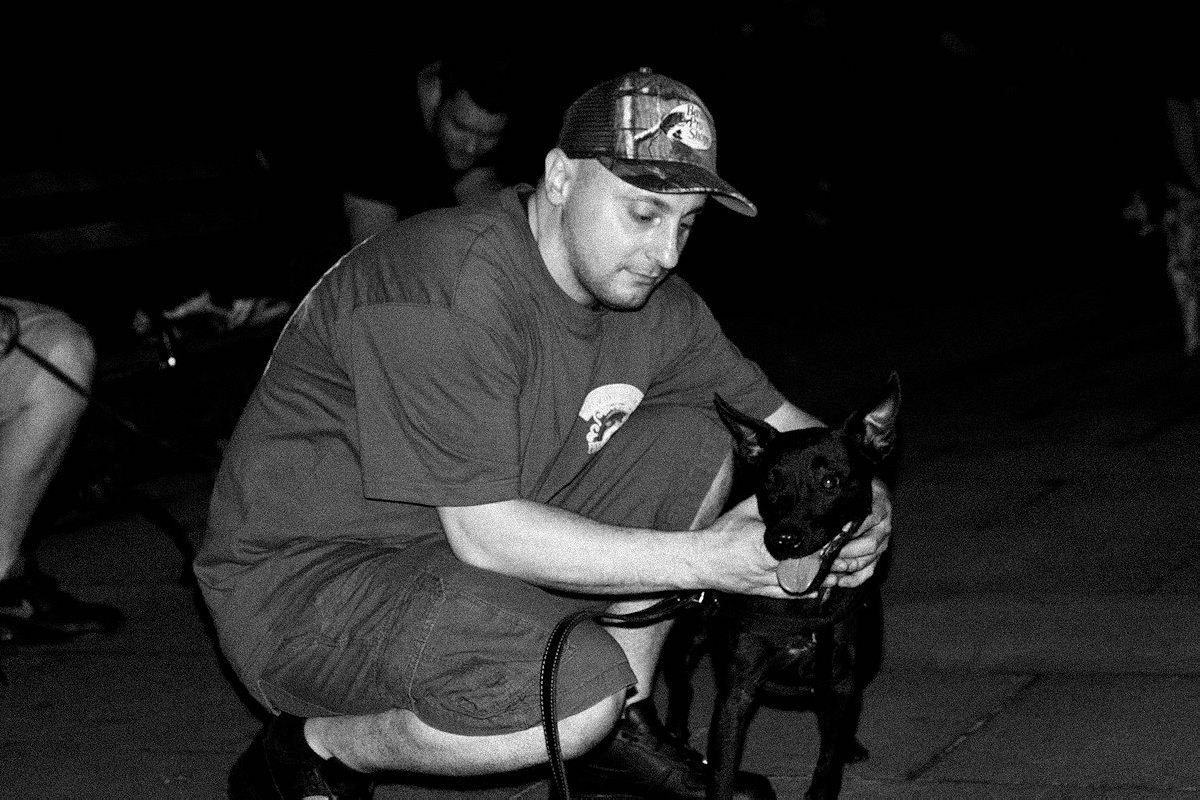
We pile into Reynolds’ Land Rover and drive north to 159th Street, where the woman said we’d find the rats we’re seeking. We cruise between Amsterdam and Broadway, where we find plenty of trash bags stacked high on the sidewalk, but again too many people. We don’t even bother to get out of the truck.
“We’re going to check out one more place,” Reynolds says from the driver’s seat.
We drive south down the FDR toward Lower Manhattan and find our way to a housing project at Broome and Ridge Streets, on the edge of Chinatown not far from the Williamsburg Bridge. We pull up to a lot surrounded by a chain link fence, inside of which several white moving vans are parked on the gravel.
Reynolds gets out of the truck and ambles over to the fence. It’s dark but I can see that there is garbage strewn across the lot.
I squint. And then I see them.
“This,” Reynolds says, fingers curled through the chain link fence, “is what I like to see. Rats. Lots and lots of rats. You seeing this?”
I’m not. In the dark, I can only just make out the garbage amid the gravel not far from our feet.
“Look closer,” he says.
I squint. And then I see them. One, two, three—dark shapes the size of a man’s loafer scurrying over the gravel lot. Four, five, six. I register this suddenly and it has the same nauseating effect as the time I cleaned out a cat bowl filled with days-old Whiskas, revealing a squirming circus of maggots underneath. Soon I realize there are dozens of rats running in and out of holes, picking at trash, nimbly scurrying under the fence toward a stack of garbage bags on the street on the other side of the lot.
We walk around to a second, trash-free parking lot at the side of the gravel lot, separated by the chain-link fence. We stop at a large white shed where Reynolds tells me trash is stored. Rats run out of the lot and into tiny holes at the shed’s base, oblivious to our presence. The smell of trash is so pervasive it’s like being wrapped in a rancid fog; I’ll smell it for hours afterward, even after I’ve showered. We continue walking toward another fence that separates the parking lot from the street. A stack of a dozen or so dark green garbage bags is piled on the sidewalk a few meters from us.
“Look at them,” Reynolds says.
The bags are moving. Alive. Zombies trying to claw their way out of body bags.
Inside, rats are eating. Periodically one will poke it’s whiskered head out of a tiny hole ripped in the bag; sometimes a rat will emerge from underneath and run off back to the gravel lot nearby. Formosa is on the other side of the fence, on the sidewalk, his camera held over the stack of bags, filming the feeding frenzy underway under the thin sheets of plastic.

We walk to the other side of the housing project, to a large cement courtyard. Even here there are rats. They emerge from one hole, run across a small section of the courtyard, pick at a piece of garbage, and disappear into another hole. Residents going in and out of the apartment building pay zero attention to them.
I tell Reynolds I have never imagined there could be this many rats in the open in a residential area. It’s skin-crawling.
He shakes his head in agreement. “This is only one of two places where I’ve been attacked by rats,” he says. “There’s no effort to contain them here. Nobody cares.”
3. Six Dead Rats
In Theatre Alley, where George Washington once walked, the hunt is on.
It seems almost choreographed, organized anarchy, like a football play emerging from a line of scrimmage. The dogs are released at once, with the short ones, the lineman, leading the charge, diving head first into the bags, burrowing, scaring out the rats. The bigger dogs, the receivers, hold back somewhat, and then dart off on long routes once a rat is spotted. Their owners are the coaches, running up and down the sidelines, calling the plays, encouraging the players.
Wearing rubber gloves, she places the bloodied rat in a plastic bag.
A rat bolts, running along the edge of a sidewalk toward an escape hole, where one a group member has placed a rock. Finding its escape route blocked, the rat shoots for a black bait station nearby to hide.
“He’s in there,” someone shouts. “Big guy.”
Reynolds flips the bait station lid open and the rat darts out. Merlin, Judy’s border terrier with the yellow vest, follows in pursuit, and in a split second the rat is in its jaws. Merlin shakes it violently until it is dead, and then jogs the carcass to Judy, who grabs it out of Merlin’s mouth and shakes it again, for good measure. Wearing rubber gloves, she places the bloodied rat in a plastic bag.
One dead rat.
The hunt continues for a few minutes. Same routine. Small dogs scare out a rat from the stack of garbage. The rat tries to escape, a dog pursues, and the rat ends up dangling from a set of jaws.
Before long, however, things have calmed. The dogs look a little bewildered: no more rats. They sniff around the bags. They bark at one another. They pee.
Paco the terrier didn’t get any rats tonight, but he did get a bagel.
“Pretty skimpy garbage tonight,” Judy says.
“You’re not eating the garbage, are you?” one R.A.T.S. member yells to her dog.
“Paco didn’t get any rats tonight, but he did get a bagel,” a man named Bill says.
Just when the hunt seems finished, Reynolds finds a small rat hiding in a bait station. When he opens the lid, the rat dashes, the dogs go wild, and then the rat disappears into a brick wall.
A moment later, it’s back out again, with Merlin in pursuit. In an instant, Merlin, tonight’s star, has the rat in his mouth, and the rat joins the others in the plastic bag.
When all is said and done, New York City has six fewer rats – their fur wet with blood, lined up on a piece of plywood in Theatre Alley.

The group decides to try its luck at a different location: Eden Alley, where, in his book Rats, Robert Sullivan spent four seasons watching the rodents. Running off Eden Alley is Ryders Alley, from which R.A.T.S. derives its name. In Eden Alley we find a large stack of garbage, but there are too many people—young men and women dressed up for a Friday night, leaving their apartments, which exit into the alley, heading out on the town.
A man in a dress shirt un-tucked over black pants stands in the alley smoking a cigarette as the group members throw around garbage bags.
“What are you doing?” he asks.
“Getting rats,” Formosa tells him.
“How do you get them?”
“The dogs. We got six tonight.”
“Great,” the man says, tossing out his cigarette, an unimpressed New Yorker. “So instead of six million… there’s six less.”
[All photos by the talented Bonnie Arbittier]
